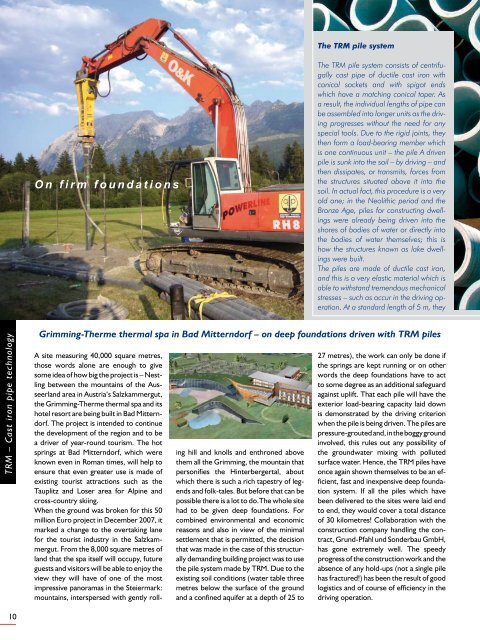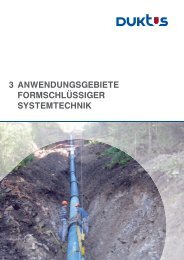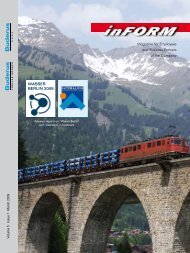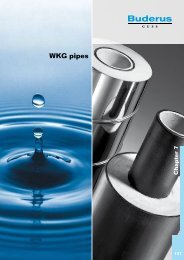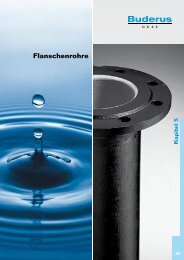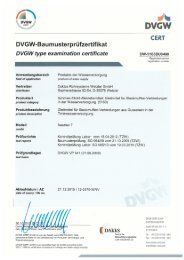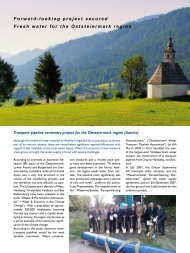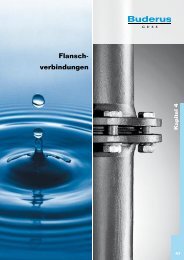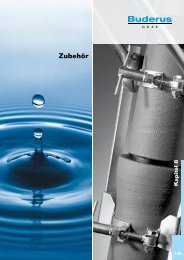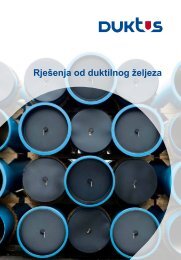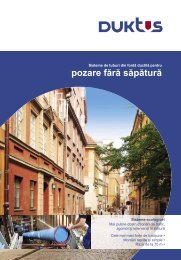InFORM 02.2008 (PDF-File) - Duktus
InFORM 02.2008 (PDF-File) - Duktus
InFORM 02.2008 (PDF-File) - Duktus
You also want an ePaper? Increase the reach of your titles
YUMPU automatically turns print PDFs into web optimized ePapers that Google loves.
TRM – Cast iron pipe technology<br />
10<br />
O n f i r m f o u n d a t i o n s<br />
A site measuring 40,000 square metres,<br />
those words alone are enough to give<br />
some idea of how big the project is – Nestling<br />
between the mountains of the Ausseerland<br />
area in Austria‘s Salzkammergut,<br />
the Grimming-Therme thermal spa and its<br />
hotel resort are being built in Bad Mitterndorf.<br />
The project is intended to continue<br />
the development of the region and to be<br />
a driver of year-round tourism. The hot<br />
springs at Bad Mitterndorf, which were<br />
known even in Roman times, will help to<br />
ensure that even greater use is made of<br />
existing tourist attractions such as the<br />
Tauplitz and Loser area for Alpine and<br />
cross-country skiing.<br />
When the ground was broken for this 50<br />
million Euro project in December 007, it<br />
marked a change to the overtaking lane<br />
for the tourist industry in the Salzkammergut.<br />
From the 8,000 square metres of<br />
land that the spa itself will occupy, future<br />
guests and visitors will be able to enjoy the<br />
view they will have of one of the most<br />
impressive panoramas in the Steiermark:<br />
mountains, interspersed with gently roll-<br />
ing hill and knolls and enthroned above<br />
them all the Grimming, the mountain that<br />
personifies the Hinterbergertal, about<br />
which there is such a rich tapestry of legends<br />
and folk-tales. But before that can be<br />
possible there is a lot to do.The whole site<br />
had to be given deep foundations. For<br />
combined environmental and economic<br />
reasons and also in view of the minimal<br />
settlement that is permitted, the decision<br />
that was made in the case of this structurally<br />
demanding building project was to use<br />
the pile system made by TRM. Due to the<br />
existing soil conditions (water table three<br />
metres below the surface of the ground<br />
and a confined aquifer at a depth of 5 to<br />
The TRM pile system<br />
The TRM pile system consists of centrifugally<br />
cast pipe of ductile cast iron with<br />
conical sockets and with spigot ends<br />
which have a matching conical taper. As<br />
a result, the individual lengths of pipe can<br />
be assembled into longer units as the driving<br />
progresses without the need for any<br />
special tools. Due to the rigid joints, they<br />
then form a load-bearing member which<br />
is one continuous unit – the pile A driven<br />
pile is sunk into the soil – by driving – and<br />
then dissipates, or transmits, forces from<br />
the structures situated above it into the<br />
soil. In actual fact, this procedure is a very<br />
old one; in the Neolithic period and the<br />
Bronze Age, piles for constructing dwellings<br />
were already being driven into the<br />
shores of bodies of water or directly into<br />
the bodies of water themselves; this is<br />
how the structures known as lake dwellings<br />
were built.<br />
The piles are made of ductile cast iron,<br />
and this is a very elastic material which is<br />
able to withstand tremendous mechanical<br />
stresses – such as occur in the driving operation.<br />
At a standard length of 5 m, they<br />
Grimming-Therme thermal spa in Bad Mitterndorf – on deep foundations driven with TRM piles<br />
7 metres), the work can only be done if<br />
the springs are kept running or on other<br />
words the deep foundations have to act<br />
to some degree as an additional safeguard<br />
against uplift. That each pile will have the<br />
exterior load-bearing capacity laid down<br />
is demonstrated by the driving criterion<br />
when the pile is being driven. The piles are<br />
pressure-grouted and, in the boggy ground<br />
involved, this rules out any possibility of<br />
the groundwater mixing with polluted<br />
surface water. Hence, the TRM piles have<br />
once again shown themselves to be an efficient,<br />
fast and inexpensive deep foundation<br />
system. If all the piles which have<br />
been delivered to the sites were laid end<br />
to end, they would cover a total distance<br />
of 0 kilometres! Collaboration with the<br />
construction company handling the contract,<br />
Grund-Pfahl und Sonderbau GmbH,<br />
has gone extremely well. The speedy<br />
progress of the construction work and the<br />
absence of any hold-ups (not a single pile<br />
has fractured!) has been the result of good<br />
logistics and of course of efficiency in the<br />
driving operation.


